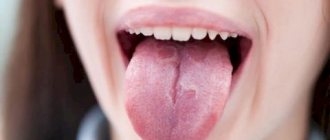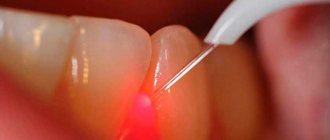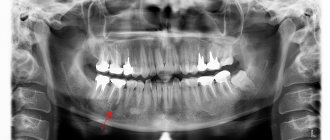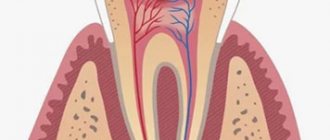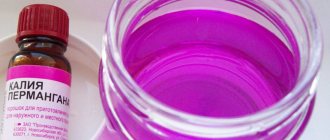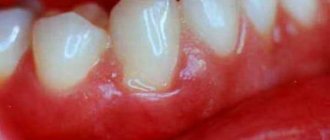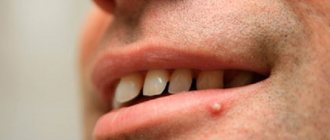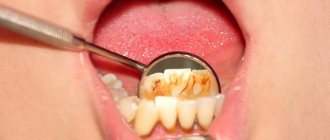- Questions and answers
- Stock
- Reviews
- Causes
- Types of cysts
- Symptoms
- Treatment
| Prices | Causes | Types of cysts | Symptoms | Treatment |
A dental cyst is a pathological neoplasm that occurs as a result of the body’s defensive reaction to infection or injury. A cyst occurs when pathogenic microorganisms that cause inflammation enter the jaw bone tissue through the root canal. Gradually, the cells involved in the disease process die, forming a cavity in the bone tissue. To prevent the spread of the process, our body forms a capsule with dense walls around the necrosis zone.
The resulting neoplasm contains inflammatory fluid, dead cells, decay products and bacteria. Sizes range from a few millimeters to several centimeters. Small ones (less than 5 mm in diameter) are called granulomas. Granuloma, cystogranuloma and cyst are stages of the inflammatory process in the bone tissue of the jaw. As long as it is small, there will be no manifestations. The number of microbes in it continues to grow, but since this happens under the control of the immune system, the process develops unnoticed. Immune cells are sent to the cyst through the blood vessels that feed the bone tissue. This is how the body tries to cope with the problem. But, if the immune system weakens, the disease enters the acute phase.
The development of the disease can lead to serious consequences. An increase in size threatens a fracture (especially of the lower) jaw, loss of teeth involved in the inflammatory process, and degeneration into a malignant tumor. Exacerbation of the disease leads to the development of periostitis, purulent abscess or even osteomyelitis. If at this stage the patient does not receive qualified medical care, sepsis may begin. This is an extremely serious condition, characterized by infection entering the blood and subsequently spreading throughout the body.
Why does a dental cyst form?
The cause of cyst formation is an untreated root canal infection.
The reasons for infection in the root of a tooth can be different:
- As a complication of insufficiently treated or completely neglected
- caries/pulpitis,
- periodontitis,
- periodontal diseases,
- inflammation under the dental crown,
- Error and infection during endodontic treatment (root canal treatment).
- Tooth injury.
- Immune disorders in the body.
- Chronic diseases of the ENT organs: runny nose, sinusitis, tonsillitis.
Children in primary and mixed dentition can also suffer from dental cysts. Even newborns may experience teething with a purulent cyst - the so-called. Bona knots.
What are the dangers of taking medications on your own?
The need for antibiotic therapy is determined by the nature of the disease and the body’s response to it. Selectivity in its appointment is explained by two reasons.
- Antibiotics affect all types of microflora, both harmful and beneficial, which in some cases can lead to problems with the mucous membranes of other organs and exacerbation of chronic diseases.
- When exposed to them, bacteria begin to mutate, forming resistance to drugs of a certain type. For this reason, first-generation drugs, such as penicillin, have already ceased to act on pathogens. Scientists have proposed new developments, but if used thoughtlessly, without following the rules of therapy, history may repeat itself.
In addition, each of the drugs has its own side effects - from nausea and itching to anaphylactic shock. Their manifestations may require immediate medical attention.
Therefore, dentists prescribe a course of antibiotics only in cases where the likelihood of complications of the disease exceeds the risks of taking the drug. At the same time, they consciously approach the choice of medication and its dosage, as well as the duration of the course. Let's look at what can lead to self-prescription of an antibiotic for tooth root inflammation.
What are dental cysts?
Types of cysts
Root cyst
Develops from granuloma as a continuation of pulpal necrosis (death of pulp tissue) and as a result of periapical inflammation. It is located in the apical (apical) third of the tooth root and sometimes has a transverse orientation due to additional canals, the initial paths for the spread of pulpous necrosis.
Root cysts are radiolucent capsules with well-defined boundaries. They can vary greatly in size from 2-3 mm to 2-3 cm. In the absence of secondary inflammation, the roots develop asymptomatically. Even the largest neoplasms do not displace teeth or expand bone tissue.
Once diagnosed, treatment requires eliminating the underlying cause. The most common treatment for pulp necrosis is endodontic treatment. If it is unsuccessful, a decision is made on surgical curettage or enucleation.
Residual
Remains after removal of the pathology. It can form in the granuloma left after tooth extraction or around the left apex of the root.
The residual cyst is clearly visible on x-ray. Its dimensions range from a few millimeters to several centimeters.
Follicular cyst on the gum
A cyst in the gum develops from a follicular sac that encloses each unerupted tooth. This is a capsule clearly visible on an x-ray, most often surrounding the crown of an unerupted tooth. May cause extensive tooth damage. It has a rapid growth rate, can move to adjacent teeth and lead to expansion of the cortical plate.
Clinically, a follicular cyst always occurs in the area where the enamel meets the cementum of the tooth (the place of attachment of the follicle). Due to its growth, adjacent teeth may tilt, and in rare cases, resorption (destruction) of tooth roots occurs. Unerupted teeth can also become displaced due to aggressive growth. If a follicular neoplasm has been identified, its treatment may include surgical curettage (curettage).
Eruption cyst
This is a fluid-filled follicular sac that usually occurs during teething. It covers the erupting tooth and often contains blood. Outwardly it looks like pronounced swelling of soft tissues of a bluish color (due to the presence of blood). Most often it occurs due to slow tooth eruption and can rupture spontaneously. However, in some cases where it is found, treatment may include surgical resection to help the tooth erupt faster.
Primordial (keratocyst)
Develops from the tooth germ as a result of degeneration of the stellate reticulum during tooth development before the onset of calcification of its tissues. Keratocysts can arise from any developing tooth germ, but most often they are localized in the area of premolars and the third molar of the mandible.
Clinically very prone to relapse. If the patient is diagnosed, treatment consists of careful curettage and close follow-up to ensure early detection of recurrence of pathology.
Lateral periodontal
The exact reasons for their occurrence are not fully known. They are rarely large. They are clearly visible on an x-ray and are most often closely associated with the lateral surface of the tooth root. Typically, teeth associated with these cysts have normal pulp. When a lateral periodontal neoplasm (cyst) is detected on the root of a tooth, treatment consists of surgical curettage without compromising the integrity of the tooth. It is important that the removed tissue is sent for histological analysis to rule out more serious pathologies such as early adamantinoma.
Calcifying odontogenic
Their etiology is also completely unknown. They can be found in any area of the supporting surface of the jaws, most often in the lower part. Morphologically they are quite diverse. Clearly visible on x-ray and may contain various opacities depending on the degree of calcification of the tumor. Once diagnosed, treatment consists of surgical curettage or resection.
Why do you need to remove the cyst?
If a dental cyst is not removed in time, even with an asymptomatic course of the disease, the consequences can be very serious - this is a real “time bomb”.
- The main danger of a cyst is that sooner or later it will destroy the affected tooth, and then “get” to the neighboring teeth.
- Cysts are reborn. Slowly but surely, so in 15-20 years it may already be a malignant formation.
- An infection is raging in the cavity of the cyst, so with a general illness, hypothermia, or a decrease in immunity as a result of simple stress, acute purulent inflammation is possible - flux, abscess, phlegmon.
- The infection can spread to adjacent lymph nodes and cause inflammation - lymphadenitis.
- Gradual thinning of the jaw bone in the affected area, due to purulent melting, turns into osteomyelitis. Even a spontaneous fracture of the jaw is possible.
- The cyst enlarges and can grow into the nasal cavity or maxillary sinus.
- Infection in the cyst can cause sepsis, a blood poisoning.
If treatment is not started on time, the tooth will have to be removed. And this is the minimum “evil”.
What are the symptoms of a dental cyst?
For a long time, the cyst may not manifest itself in any way until it becomes large enough in size, so it is very rare that a cyst is diagnosed at an early stage of the disease. This mostly occurs accidentally when the patient is having an x-ray for another reason.
At a later stage, the patient begins to worry about:
- Aching pain that gets worse over time. Such pain is difficult to relieve with regular painkillers.
- Pain when biting.
- Swelling of the gums and/or cheeks.
- An abscess, gumboil, or fistula may form on the gum.
- General malaise, fever.
Abscess on the gum due to periodontitis
With this disease, ulcers often form. The drugs only temporarily relieve discomfort, but the pathological process continues to develop, gradually destroying the bone tissue of the jaw.
Timely intervention by the dentist allows you to remove the source of infection and achieve 100% cure.
Antibiotics, rinses, physiotherapy - all this is included in the treatment of purulent infection. It is important not to let the process take its course, because complicated purulent infections are extremely difficult to treat.
What are the consequences of negligence?
As a rule, aching pain speeds up the patient, and few people delay a visit to the doctor. And this is correct, because even if there are no painful symptoms, swelling of the gums is quite enough to urgently consult a dentist for consultation, diagnosis and treatment (after which the swelling soon goes away).
In the absence of qualified and timely assistance, the patient may develop very serious complications. Thus, a slight inflammation can quickly affect the entire gum and even the jaw bone. And this will require a long and serious treatment with antibiotics, in addition, the prospect of inevitable surgical treatment of teeth in a dream looms before him - to eliminate the source of infection.
How is a dental cyst treated?
The first thing that should be said is that today a dental cyst is successfully treated with a high percentage of preservation of the affected tooth, although in the past the diagnosis of a “cyst” meant 100% removal.
There are 2 main approaches to treatment:
- Therapeutic. Therapeutic treatment of dental cysts is used when
- There is access to the dental canal through the dental crown
- The canals are not sealed or can be opened
This method of treatment is very similar to the treatment of periodontitis, with the only difference being that the doctor additionally removes pus from the cyst cavity and injects special medicinal preparations into the root canal.
This treatment takes at least 1-2 visits, is carried out under sterile conditions, using a rubber dam and a dental microscope, because requires special care from the doctor to prevent relapses.
Treatment of cysts with laser with access through the coronal part of the tooth is another type of therapeutic treatment. Its main difference is that the laser immediately completely disinfects the area of the removed cyst, the treatment is quick and bloodless, the disadvantages include the risk of burns.
There are several methods for surgical removal of cysts, but cystectomy - complete removal of the cyst with all its contents - is the most modern and most effective of them.
Cystectomy is indicated for:
- A sealed root canal that is difficult to open.
- The affected tooth is replaced with a crown
- Pain, swelling of the cheeks/gums.
The best folk recipes
We bring to your attention popular effective folk recipes that allow you to get rid of pain, inflammation, swelling, thereby increasing the chances of a full recovery without surgery.
Salt water rinse
Helps get rid of pain, germs, swelling. You should rinse your mouth with warm salt water, holding it in your mouth for 1-2 minutes. You can add soda and a few drops of iodine to the solution. The procedure must be carried out 5-6 times a day.
Treatment with alcohol tinctures
They have disinfectant and anesthetic effects. You can rinse your mouth with ordinary vodka or alcoholic tinctures of medicinal herbs. Horseradish tincture is often used; it has antibacterial properties. The crushed root must be poured with medical alcohol and left for three days in a cool place. A similar result is obtained by using tinctures of calendula, ficus, and aloe.
Gargling with herbal decoctions
When treating a cyst, rinsing the mouth is a necessary procedure that allows you to eliminate the source of infection, reduce pain, and eliminate inflammation. The use of herbal decoctions and infusions can effectively complement basic therapeutic procedures.
When treating cysts, the most effective is a decoction of sage, chamomile, calendula, thyme, eucalyptus, hyssop, yarrow, and horsetail. Pour two tablespoons of herbal mixture into a glass of boiling water, let it brew, and strain. Rinse your mouth with the resulting product as often as possible.
Sage has anti-inflammatory and disinfectant properties. Boil one tablespoon of flowers for 20 minutes in 200 ml of water, use for rinsing. To enhance the healing effect, it is advisable to add killer whale root to sage.
You should rinse your mouth with decoctions of medicinal herbs often, up to 10-12 times a day.
It is necessary to steam the herbs daily, store the finished decoction in the refrigerator for 24 hours, and warm it up slightly to a temperature of 36-37 degrees before rinsing. Rinsing with a solution that is too hot can aggravate the situation; the cyst can develop into a gumboil.
How is surgery to remove a cyst (cystectomy) performed?
Removal of the cyst is carried out by a dental surgeon in a surgical office, on an outpatient basis, the operation usually lasts about half an hour, an hour after the manipulation the patient can go home. Improvement in the patient's condition should occur 6-8 hours after the operation. A sick leave certificate is issued for the recovery period - until the stitches are removed.
To relieve all pain, the patient is given local conduction or infiltration anesthesia; we also numb the injection site with an application gel. After surgery, painkillers in tablets are prescribed for the first time.
I Preparatory stage
- The patient is diagnosed by a surgeon, and a consultation with the attending dentist-therapist is required.
- It is advisable, if the operation is not urgent, to provide the patient with professional hygiene and sanitation of the oral cavity before surgery - this reduces the presence of infection in the oral cavity and healing proceeds faster.
II Carrying out the operation
- The patient is given anesthesia.
- The surgical field is treated with an antiseptic.
- The dentist-surgeon separates the mucoperiosteal flap from the bone.
- Access to the affected area is provided, the cyst along with the affected part of the apex of the tooth is removed.
- The cavity is thoroughly cleaned and washed with an antiseptic.
- An antiseptic is injected into the cavity and the wound is sutured.
- During the recovery process, the cavity heals on its own and the bone tissue is restored.
III Postoperative period
- After the operation, you should not eat for 4 hours, then the food should not be hot, liquid and gentle.
- The patient is prescribed antibiotics to fight the infection and painkillers.
- Hygiene can be carried out according to the standard scheme one day after surgery, according to the recommendations of your doctor.
- Antiseptic rinses and healing gels are prescribed.
- Swelling of the gums and face may occur for several days.
- NOT RECOMMENDED:
- Warm the surgical site, because re-development of the infection is possible.
- Take medications without a doctor's prescription.
Treatment of an abscess on the gum
After examining the oral cavity and studying the image, the doctor identifies the cause of the suppuration and prescribes treatment, which can also be either conservative or surgical dental treatment under general anesthesia.
Conservative treatment: the canals are opened, then an antiseptic is placed into the tooth cavity. Within a few days, the drug destroys the infection, and the doctor refills the canals. The formation of pus completely stops, swelling and redness of the soft tissues disappear.
Surgical treatment: the doctor makes an incision in the gum or removes a tooth.
Prevention of dental cysts
Taking standard care of your dental and general health will help prevent the development of cysts.
To prevent dental cysts from bothering you, you must:
- Undergo regular preventive examinations with your dentist every 6 months and a professional hygiene procedure. Do not refuse if the doctor offers you an X-ray examination - he has reasons for this.
- Treat caries and pulpitis in a timely manner.
- To identify hidden caries at an early stage of the disease, for this in our clinic we use digital (not x-ray) diagnostics using the Diagnocam apparatus. We recommend undergoing such diagnostics at least once every six months.
- Brush your teeth well yourself using dental floss, irrigator, and mouthwash. Pay attention to cleaning your tongue.
- Strengthen immunity.
